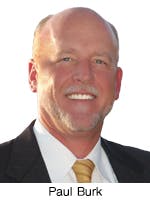As 2014 wound down, industrial distribution executives said they experienced a better year than 2103 and were reasonably upbeat as the New Year approached.
At Motion Industries in Birmingham, Alabama, senior vice president Randy Breaux saw overall improvement.
“It’s been a little bit better than 2013,” Breaux explained, “and the second half of the year has shown steady improvement.”
Breaux explained that the growth was the result of a number of Motion’s product lines and customer bases doing what he calls “good and steady business.”
“We’re seeing market increases pretty much across the board,” he said. “People are spending a little bit more money on new projects … and on maintaining equipment in the plants.”
Motion is a very diverse company, with an array of product lines and a customer base heavy in the OEM and MRO industries.
“Primary industries for us would be food and beverage, oil and gas, pulp and paper, iron and steel,” Breaux explained. “However, we participate in just about every industry sector out there.”
Though product diversity can provide a bit of a safety net against an economic downturn, Motion had no need for one in 2014, Breaux explained.
“All of our product lines are growing. We have a very large concentration in the bearings and power transmission product lines,” he said. “Those product lines are growing, and [they] picked up in the second half of the year after being a bit slow in the first half. Our industrial supplies product lines have also been growing nicely again this year. Those product lines, as well as our fluid power and pneumatics products, are all growing at a very good rate right now.”
At Cleveland-based BDI-USA, John Ruth, president and chief operating officer, was slightly less upbeat, calling 2014 “an average year for BDI. Growth has been strongest in food and automotive and soft in defense.”
Ruth referred to the difficult winter of 2013-14 and its effect on business.
“The year started slowly, with severe weather impacting our customers, but improved steadily thereafter,” Ruth said.
As at Motion, Ruth and BDI know that their diverse choice of products and customer base can help assure a steady flow of business at least.
“Our food customers tend to fare well in an economic downturn, but we aren’t isolated from macroeconomic forces,” Ruth explained. “We do find that services and repair grow when the economy softens and we are well positioned in both areas. [But] MRO in food has been very strong in 2014.”
At Steven Engineering, Paul Burk, vice president of marketing, described a “very strong” 2014 but explained that the company’s focus on products and service, rather than product and customer diversity, may have been the key.
“We actually are not as diverse as a lot of the other distributors,” Burk explained. “I actually think we’re fairly well focused, but we’re not a broad line distributor. When you look at our website … what is listed there are the manufacturers but also the brand names. Because there are so many acquisitions in our business, we do both. We actually only represent 49 manufacturers. If you go to our website, you would think we have over 100.”
Headquartered in San Francisco, Steven Engineering had a strong 2014.
“We are exceeding our forecast both from the top line and a bottom-line perspective,” Burk said. “We saw some softening toward the middle part of the year, during July and August, primarily. We have invested heavily in infrastructure. We brought online some new services that have paid huge dividends for us. And we have started a new initiative for a portfolio of products that we did not have before. And that is quickly proving to be a good investment.”
Burk described Steven Engineering’s focus as in electrical, automation, and pneumatic controls. But the company also added motion control in 2014.
“Our motion initiative is a three-year initiative that we kicked off this past August,” he said. “We are focusing on seven core manufacturers, and that gives us the motor, the controller, and the mechanical side of a motion control solution. They are all best-in-class lines. Motion is not an easy sell. So for us, it has been a very large learning curve.”
With growth has come a certain amount of new hiring. At Motion Industries, Breaux explained that new hires were also the result of some acquisitions.
“We have hired some new people this year. We are continuing to increase the level of talent with new hires,” he said. “Also, some of our new talent comes from acquisitions we make. We made one significant acquisition this year [Commercial Solutions, Inc. in Canada] and we continue to look for other acquisitions that make strategic sense.”
BDI made new hires on the technology side of the business.
“We hired a number of technical people in 2014 to work on our SAP, e-business, and supply chain projects, and [we] opened several new branches,” Ruth explained. “We will open several more branches in 2015 and add resources as needed for our technology-based projects.”
The topic of new hires is also the source of potential concern for Ruth, one that many in distribution have voiced: how to attract new people to the distribution end of the supply chain.
“A topic of conversation at every Bearing Specialist Association and Power Transmission Distributors Association meeting we attend is how to attract new people to the distribution industry,” he said. “Not enough people are aware of the great careers available [here].”
At Steven Engineering, the mood is upbeat and Burk explained the company hopes to expand to other Western states including Oregon, Washington, Arizona, Colorado, and Utah in 2015 and beyond.
“What we see, at least for our ability, is to be able to expand geographically in the next five years,” he explained. “That is a real core focus. Right now, we are in primarily California, which is about 70% of our revenue. So we’re looking to expand more into the Western region as part of our growth strategy.”










